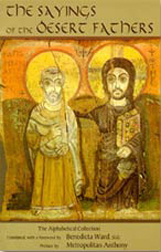Book Notes
 Benedicta Ward, translator, The Sayings of the Desert Fathers; The Alphabetical Collection (Kalamazoo: Cistercian Publications, 1975, 1984 revised edition), 269pp.
Benedicta Ward, translator, The Sayings of the Desert Fathers; The Alphabetical Collection (Kalamazoo: Cistercian Publications, 1975, 1984 revised edition), 269pp.
For thirty years now Sister Benedicta Ward's translation of the sayings of 131 of the earliest monastics has served as an indispensable text for English speakers. In addition to her brief foreword and short biographical introductions (when they are known), the book includes simple maps on the inside front and back covers, a short glossary of terms, a chronological table of key events in the development of desert monasticism, a bibliography that is all too short and badly dated, and then two indices of key concepts, people and places. The sayings themselves stand alone without commentary. For contemporary extrapolations one can turn to the fine books by Archbishop Rowan Williams (Where God Happens, 2005) and John Chryssavgis (In the Heart of the Desert, 2003). For more complete primary resources, see the two works by John Cassian (360–435), Institutes and Conferences (900-plus pages), in which Cassian relates what he learned from and about the earliest monastics.
Beginning in the third century, three monastic experiments emerged in Egypt. St. Anthony (251–356), an uneducated Copt, is generally hailed as the father of the hermit monasticism centered in lower Egypt. Thanks to The Life of Saint Anthony by Athanasius, we know as much or more about Anthony than any other of the early ascetics. Other monks cooperated and collaborated in "cenobitic" monasticism. Pachomius (290–347) is generally credited with instigating this communal form of flight to the desert. Finally, in Nitria and Scetis small groups of monks lived near one another under the direction of an elder or "abba." In addition to Egypt, desert monasticism flourished in Syria, Asia Minor and in Palestine.
It's easy to dismiss the eccentricities of a Simon the Stylite (d. 459), who sat atop a fifty-foot pole outside of Antioch for forty years, or the ascetic excesses of food and sleep deprivation, but we honor these saints for their unique experimental spirituality that explored just what the words of Jesus might mean: "Deny yourself, take up your cross, and follow me." They stopped at nothing in "their lifetime of striving to re-direct every aspect of body, mind, and soul to God, and that is what they talked about" (Ward) in these "sayings."
In these sayings we are taught to "expect temptation until your last breath." That means doing battle with one's inner appetites, drives, thoughts, attachments (for example, to wealth) and desires. It also means the further you travel on the Christian journey the more you realize the breadth and depth of the struggle. Consequently, these monastics were above all things modest, non-judgmental, and deeply tender in regard to our human weaknesses. They were reluctant to take Christian office, made the certainty of their death a force for good in life, modest in what they thought they might know about Scripture, eager to keep silent, and appreciative of the diverse ways that each monk worked out his salvation. Ultimately, and in contrast to so much Christian spirituality of today, these desert monastics recommend a "hidden" form of discipleship, the focus of which is the interior geography of the human heart regardless of where they body finds itself. I have found these ancient saints to be wise guides for our contemporary world.


